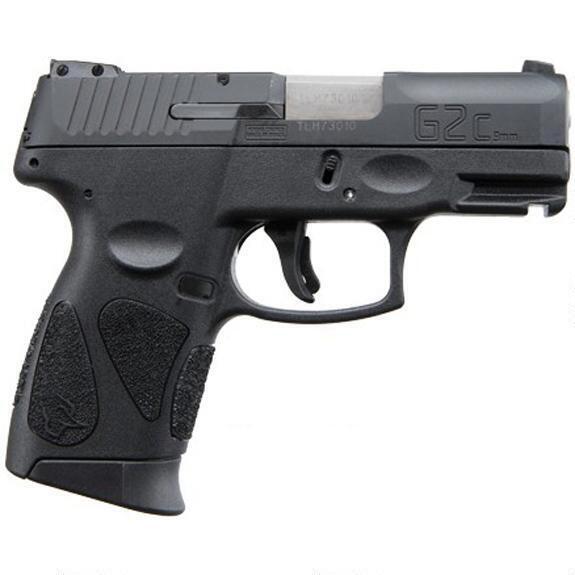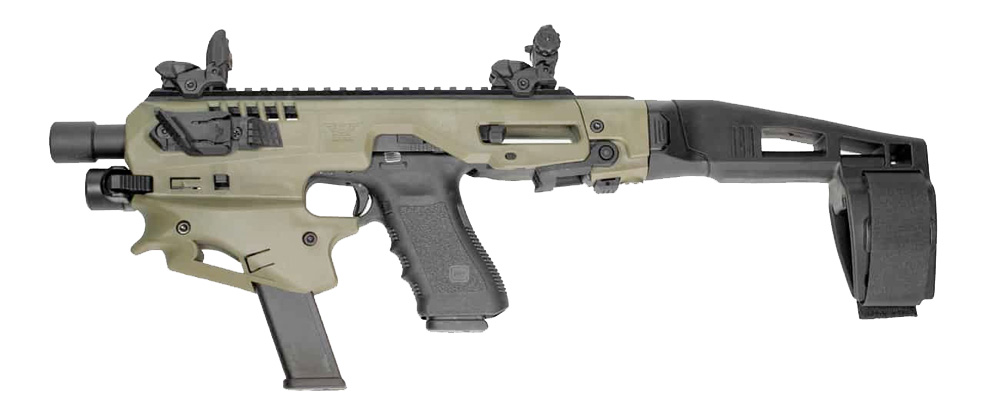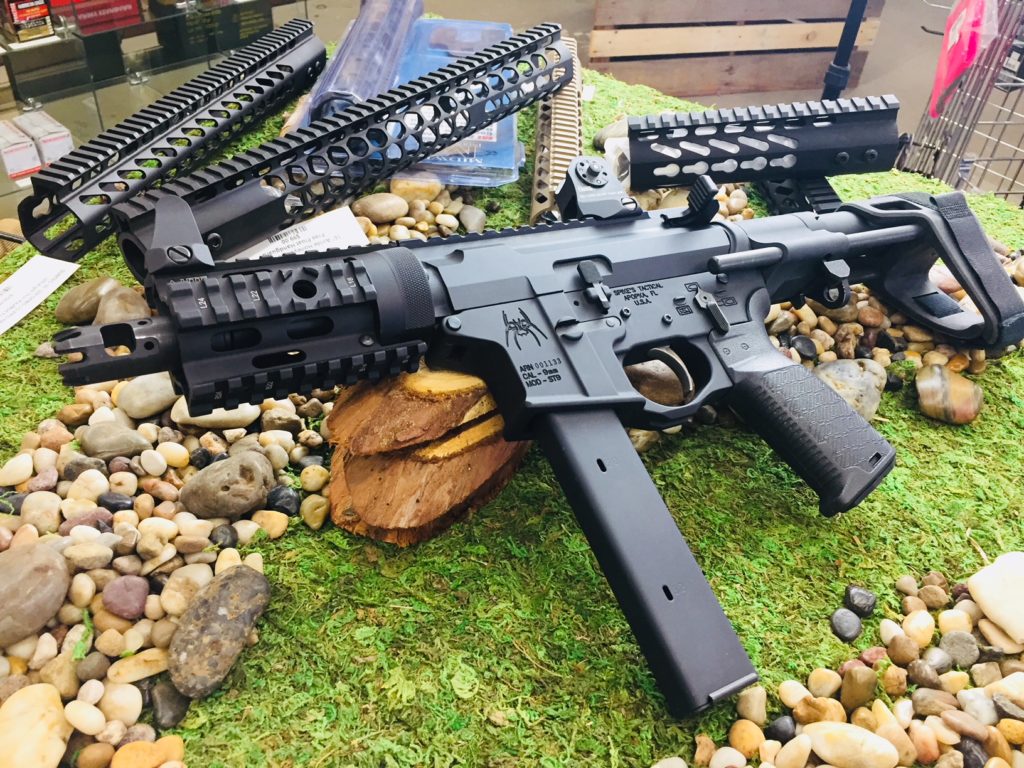What are the best AR-15 calibers? This is a question we get asked often. The AR pattern rifle is the most popular shooting platform in the USA. Anyone who owns one will tell you it offers unrivaled versatility and modularity when it comes to how you configure it to both look and perform.
But many believe this style of rifle only comes in one flavor: the 5.56×45 caliber also known as 5.56 NATO. While 5.56×45 (and usually interchangeable .223 Remington) may be what the majority of AR-15s are manufactured to shoot, there are literally dozens of other caliber choices out there that are potentially better suited for different applications.
With that in mind, the goal here is to keep things in layman’s terms, skipping the hardcore numbers and charts, and certainly not to weigh-in on the “which is better” argument. As we always seem to be saying, there is no “best” choice. Physics is always a trade-off. Each does one does something a little better than others, while at the same time doing something a bit worse than the others.
Your own needs and circumstances will determine which will be the best fit for you, and hopefully after reading this, you’ll have a better idea of which direction you want to take your first or next AR-15, caliber-wise.
Why Do Alternate Calibers Exist for the AR-15?
Simply put, to extend the usability of the AR-15 platform, for both military and civilian use.
Many of the caliber alternatives have sprung forth in recent years due to the evolution of the modern battlefield. Close-quarters skirmishes in urban environments have become far more common than the wide-ranging battlefield engagements of previous wars. Some found the 5.56 NATO round lacking for this purpose, so new attempts to create better ammunition to fill that role have resulted. As ammunition manufacturers come up with, those cartridges become more practical for civilian uses like hunting.
Some of the AR’s alternate calibers were created in attempt to make the AR-15 more accurate and effective at longer ranges. Others trend more towards being more effective in CQB or defensive scenarios.
What to Know When Choosing an Alternate Caliber?

The main thing to keep in mind when it comes to AR-15 calibers is that there is no “magic bullet” (pun intended). Everything is a trade-off. An AR-15’s magwell opening is a fixed size, and therefore any cartridge is going to be confined to a maximum length that can fit through it.
So if the cartridge can’t get longer, then something else has to give. The larger the size of bullet, the less room there is for powder without moving to a wider case diameter. Moving to a wider case means to accommodate a larger bullet and/or more powder means less magazine capacity.
In other words, bigger holes are going to come at the cost of effective range. Want to shoot a .50 caliber bullet from an AR? No problem – there is definitely such a thing. Just don’t expect to go very far before hitting the ground, and don’t expect the magazine to hold 30 rounds.
Indeed, the key qualifier phrase when it comes to alternate calibers is, “…from the AR-15 platform.” None of these calibers are suddenly going to turn your AR into a big-game-African-plains-safari rifle, or lights-out-from-a-mile-away sniper platform. But they can allow you to increase ballistic performance in certain ways when shooting from the AR-15 platform, when compared to the standard 5.56 NATO cartridge.
Don’t get us wrong, the 5.56 NATO can still be an effective round, but it’s main attraction to civilian shooters is its comparatively cheap cost per round. Both .223 Remington and 5.56 NATO ammo is plentiful and reasonably priced compared to most of the other choices.
Multiple Uppers
So alternate calibers might be better for some things, but also more expensive. That financial burden might negatively impact the owners ability to shoot and train. No bueno.
Thankfully, you don’t have to choose. Due to the modularity of the AR-15 platform, having to own two completely separate rifles in order to shoot two different calibers is an obsolete concept.
In fact the only semi-permanent component that needs to change in order to shoot an alternate caliber is the barrel. Some may require a dedicated bolt and or dedicated magazine. While bolts and mags are easy to swap without specialized tools, changing out a barrel can be a cumbersome process and beyond the skills and tools of many shooters. There’s a better way.
If you own an AR-15 you know that with the push of two pins, the upper assembly can detach from the lower. When it comes to shooting alternate calibers, there are no dedicated permanent components contained within the lower – every specific part exists in the upper.

So by buying or building a separate upper configured for a different caliber, it’s possible to go from shooting one caliber to another and back again in mere seconds simply by swapping uppers. You have the best of both worlds.
Indeed, you’ll find this is the route many AR owners go – a rifle originally built to fire .223/5.56 for training or recreation, supplemented by one or more uppers which have been purpose-built for shooting one (or more) other calibers.
The other bonus here is that no matter how many uppers you have, you can still tell your spouse that it’s only one gun and technically not be lying!
Not that we would ever do that.
Safety First
One thing that can’t be overstated is that the convenience of swapping calibers must be tempered with diligence. Given that many alternate calibers can utilize the same magazines and other parts as standard 5.56 NATO, the potential for mix-ups can be high.
Shooters must always be careful to ensure the proper cartridge is used with the proper corresponding components. At best, attempting to fire a mismatched caliber could result in catastrophic damage to the firearm. At worst, it could result in serious injury or death to the shooter or those around him or her.
Specially marked components and magazines are available to help cut down on confusion. We highly recommend purchasing them if you wish to shoot more than one caliber with your AR-15, or at the very least marking your caliber-specific parts or full uppers somehow to help ensure there are no accidents.
Popular Caliber Rundown
Let’s take a look at five of the more popular and established alternate AR-15 calibers that have enjoyed widespread adoption and are reasonably available in the market.
300 AAC Blackout (BLK)
Dedicated components: Barrel
Common Bullet Specs: .30 cal, 120gr Supersonic/220gr Subsonic
Commonly called 300 Blackout, think of it as a .308 caliber bullet stuffed into a standard 5.56mm case. Originally developed as a military cartridge to bridge the gap between pistol caliber size and sound suppression, but with the greater reach and power of rifle rounds while using a standard 5.56 NATO bolt and standard AR magazines at their full capacity. In its supersonic format, 300 Blackout achieves ballistics similar to the 7.62×39mm.
Pros: More punch at short to medium ranges. Shares almost all components with standard AR. Shoots suppressed subsonic ammunition very effectively. Good ballistic performance from a comparatively short barrel length (8-10 inches). Ammunition is fairly easy to find.
Cons: Shorter effective range compared to 5.56 NATO. Moderate to high ammunition cost ($0.50 and up).
Why you might want it: Versatility and easy interchangeability. Its relatively short optimal barrel length makes it a great candidate for pistol or SBR-type setup, and when suppressed with subsonic ammo, can make a very effective PDW for home defense compared to other rifle calibers. As a supersonic offering, it’s viable for hunting medium game or for effective tactical use out to 300 yards. Basically, 300 BLK can be suppressed great and does everything else pretty well as far as AR-15 calibers go.
7.62×39
Non-standard components: Barrel, Bolt, Magazine
Common Bullet Weight: .30 cal, 120gr
Sometimes called “7.62 x 39 Soviet”. Instead of coming up with a new cartridge, why not just make the AR able to shoot something that’s already widely available? Sounds like a good idea, right? The 7.62×39 is the same cartridge fired by the venerable AK-47, the most used military rifle in the world. It’s a proven hard-hitting performer on the battlefield.
Pros: Ammunition availability and cost. Increased muzzle energy.
Cons: Not a lot of variety when it comes to specialized bullets.
Why you might want it: At the time of this article, 7.62×39 in an AR-15 isn’t as popular as it was in the recent past due to the return of readily available 5.56 NATO ammo to the marketplace. If you happen to already have an AK or SKS that shoots 7.62 x 39, then having an AR-15 that can shoot the same ammunition may have merit. Supersonic 300 BLK basically matches its performance, so there isn’t much to be gained on that front, however, having an upper built to shoot 7.62×39 is the ultimate insurance against 5.56 NATO shortages.
6.5 Grendel
Non-standard components: Barrel, Bolt, Magazine
Common Bullet Weight: 6.5mm (.264) 123gr
The established long-range king of the AR-15, 6.5 Grendel is an intermediate cartridge designed as a low recoil, high accuracy, 200–800 yard round that actually surpasses the larger .308 Winchester round in some ways. 6.5 Grendel overcomes the bullet vs powder capacity issue by using a larger diameter case at the expense of magazine capacity.
Pros: Low-recoil, flat-shooting round provides more punch at longer ranges than other cartridges. Low-cost, steel-cased ammo available for cheaper range plinking.
Cons: Less magazine capacity. Long barrel length needed for ideal ballistics (20+ inches). Expensive hunting/match grade ammunition. Ammunition not widely available.
Why you might want it: The 6.5mm projectile traveling at high velocity provides vastly superior ballistics on-target at longer distances compared to pretty much any AR-15 alternative. If you’re hoping to use your AR-15 for medium to long range hunting, the Grendel is the perfect choice. It’s very effective for medium-sized game out to 500+ yards, and can accurately punch paper much further.
6.8 Remington SPC
Non-standard components: Barrel, Bolt, Magazine
Common Bullet Weight: 6.8mm, 110gr
Another military-developed round, the 6.8 SPC was designed for better terminal effectiveness at the shorter ranges and tighter spaces of urban combat experienced in Iraq. While optimal ballistic performance of 5.56 NATO requires a barrel 20″ or greater, 6.8 SPC is optimized for carbine-length firearms equipped with barrels 14-16-inches utilized by modern M-4 military carbines. From that barrel length, 6.8 SPC delivers 44% more energy than the 5.56mm NATO out to 300 yards or so.
Pros: Good balance of muzzle energy and effective range for tactical use. Reasonably available ammunition.
Cons: Ammunition cost and availability. Scarcity of purpose-built commercially produced hunting rounds limit usability, but selection is improving.
Why you might want it: It’s an excellent tactical round, optimized for the AR-15 configurations used by many civilian owners within distances most civilians would hypothetically be shooting under normal circumstances. What it gives up in effective range to 5.56 NATO, it makes up for with greater barrier penetration and energy on target.
.458 SOCOM
Non-standard Components: Barrel, Bolt, Magazine (varies), Upper Receiver
Popular Bullet Weight: 300gr supersonic – 500gr subsonic
SOCOM is the acronym for the Special Operations COMmand, and this cartridge was developed to provide huge energy on targets at close ranges – a one-shot solution to almost any tactical problem. Though there are slight differences between them, .450 Bushmaster and .50 Beowolf also fit this mission, turning the AR-15 from a surgical military firearm into a short-range sledgehammer.
Pros: Huge muzzle energy.
Cons: Short effective range. Low magazine capacity. High-cost ammunition. Commercial ammunition availability.
Why you’d want it: Though it has tactical limitations such as low magazine capacity, no one can argue that it’s an effective “man-stopper”. In addition to short-range hunting of medium to large game, it’s gaining popularity as an excellent boar hunting option in the southern US, where most shooting is done within 100 yards.
Summary
As I mentioned, these are just a few of the more popular caliber choices available. But there are many more to explore, all offering slightly optimized ballistics in some category to help you get a lot more mileage out of your AR-15.
Shooting any of the alternative AR-15 calibers is all about understanding the benefits and limitations of the specific cartridge, and implementing it accordingly. Pick the right tool for the job.
Some of the questions you’ll want to ask yourself before buying or building an AR-15:
- Will this be the only AR caliber you plan to own? Do you plan to buy/build a separate complete upper?
- What other firearms do you own, and for what purpose?
- Will this AR be used for self or home defense?
- Do you want to hunt with this AR?
- What type of hunting do you plan to do, or what types of animals do you plan to hunt?
- Where do you generally plan to hunt?
- To what degree will ammunition cost and availability play into you choice?
- To what degree will component cost and availability factor into your choice?
The folks here at JTAC Weaponry USA specialize in ARs and AR builds, and we’ll be happy to help anyone find or build their ideal firearm setup. We know our stuff, because we own it and shoot it ourselves.
If you’re thinking of getting into the AR world, or are an AR owner looking to extend your rifle’s capabilities, reach out and talk to us today!
Be safe and happy shooting!







